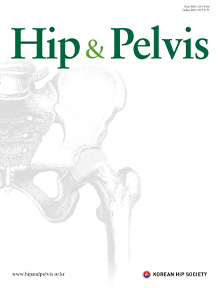Quick links
Related article in
-
Original ArticleDecember 1, 2011
 0
0
 63
63
 20
20
Ceramic-on-Ceramic Bearing Total Hip Arthroplasty: Five-Year Midterm Follow-up Results
Soo Jae Yim, MD, Mun Suk Jang, MD, Joon Hee Yoon, MD, Sang Hyok Lee, MD, Hee kyung Kang, RN
J Korean Hip Soc 2011; 23(4): 268-274AbstractPurpose: We believe that cemented femoral stems will relieve the stiffness of ceramic-based bearings, resulting in reduced complication of ceramic-on-ceramic bearing total hip arthroplasty (THA). The purpose of this study was to evaluate the midterm effect of ceramic-on-ceramic bearing THA using cemented femoral stems.
Materials and Methods: We studied 32cases (30 patients) of THA using ceramic-on-ceramic bearing cemented femoral stems and 33 cases (31 patients) of THA using ceramic-on-ceramic bearing cementless femoral stems. All total hip arthroplasties were performed between January 2004 and December 2005 and were followed up for more than 5 years. The clinical results and radiographic results were evaluated.
Results: The mean HHS improved from points pre-operatively to points at the last follow-up in both the cemented and cementless stem groups (P<0.05). The mean WOMAC score also improved from points pre-operatively to points at the last follow-up in both the cemented and cementless stem groups (P<0.05). But no statistically significant difference was noted between the cemented and cementless stem groups in HHS and WOMAC scores (P=0.304, P=0.769). There were 3 patients with a sense of discomfort on ambulation and 5 patients with thigh pain in the cementless stem group and no cases in the cemented stem group. There was no instance of acetabular loosening in either group. Subsidenc of the cemented femoral stem was less than 1mm in 30 cases and less than 2 mm in 2 cases. All cementless femoral stems acquired firm bony union.
Conclusion: Midterm results showed no statistical links between ceramicon-ceramic-bearing THA using cemented femoral stems or cementless femoral stems. -
Review ArticleMarch 1, 2024
 0
0
 750
750
 235
235

Pathophysiology and Treatment of Gout Arthritis; including Gout Arthritis of Hip Joint: A Literature Review
Yonghan Cha, MD
Hip Pelvis 2024; 36(1): 1-11 , Jongwon Lee, MD
, Jongwon Lee, MD  , Wonsik Choy, MD
, Wonsik Choy, MD  , Jae Sun Lee, PhD*,†
, Jae Sun Lee, PhD*,†  , Hyun Hee Lee, MD‡
, Hyun Hee Lee, MD‡  , Dong-Sik Chae, MD‡
, Dong-Sik Chae, MD‡  AbstractGout is triggered by the accumulation of uric acid in the body, leading to hyperuricemia. Genetic, metabolic, and environmental factors can influence this condition. Excessive uric acid buildup results in the formation of monosodium urate (MSU) crystals, which precipitate in specific areas of the body, including the joints, where they can cause symptoms of gout. While the acute and chronic symptoms of gout have been well-documented, diagnosis of gout affecting the hip joint poses significant challenges. The global incidence of gout, the most prevalent form of inflammatory arthritis, is on the rise. Evaluation of the clinical signs, laboratory results, and imaging results is generally required for diagnosis of gout in cases where MSU crystals have not been detected. Hyperuricemia is considered a primary cause of arthritis symptoms, and comprehensive guidelines for treatment are available. Therefore, the choice of medication is straightforward, and moderate effectiveness of treatment has been demonstrated. Gout is a chronic disease, requiring lifelong uric acid-lowering medications, thus application of a treatment strategy based on the target blood uric acid concentration is necessary. Consequently, cases of gout will likely be observed more frequently by hip surgeons in clinical scenarios in the future. The objective of this review is to provide an overview of the pathophysiology of gout and subsequently examine recent advances in diagnostic methods and therapeutic agents based on an understanding of its underlying mechanisms. In addition, literature on gout-related issues affecting the hip joint, providing a useful reference for hip surgeons is examined.
AbstractGout is triggered by the accumulation of uric acid in the body, leading to hyperuricemia. Genetic, metabolic, and environmental factors can influence this condition. Excessive uric acid buildup results in the formation of monosodium urate (MSU) crystals, which precipitate in specific areas of the body, including the joints, where they can cause symptoms of gout. While the acute and chronic symptoms of gout have been well-documented, diagnosis of gout affecting the hip joint poses significant challenges. The global incidence of gout, the most prevalent form of inflammatory arthritis, is on the rise. Evaluation of the clinical signs, laboratory results, and imaging results is generally required for diagnosis of gout in cases where MSU crystals have not been detected. Hyperuricemia is considered a primary cause of arthritis symptoms, and comprehensive guidelines for treatment are available. Therefore, the choice of medication is straightforward, and moderate effectiveness of treatment has been demonstrated. Gout is a chronic disease, requiring lifelong uric acid-lowering medications, thus application of a treatment strategy based on the target blood uric acid concentration is necessary. Consequently, cases of gout will likely be observed more frequently by hip surgeons in clinical scenarios in the future. The objective of this review is to provide an overview of the pathophysiology of gout and subsequently examine recent advances in diagnostic methods and therapeutic agents based on an understanding of its underlying mechanisms. In addition, literature on gout-related issues affecting the hip joint, providing a useful reference for hip surgeons is examined.
- 1

Vol.36 No.1
Mar 01, 2024, pp. 1~75
Most Keyword
?
What is Most Keyword?
- It is most registrated keyword in articles at this journal during for 2 years.
Most View
-
Pathophysiology and Treatment of Gout Arthritis; including Gout Arthritis of Hip Joint: A Literature Review
Yonghan Cha, MD
Hip Pelvis 2024; 36(1): 1-11 , Jongwon Lee, MD
, Jongwon Lee, MD  , Wonsik Choy, MD
, Wonsik Choy, MD  , Jae Sun Lee, PhD*,†
, Jae Sun Lee, PhD*,†  , Hyun Hee Lee, MD‡
, Hyun Hee Lee, MD‡  , Dong-Sik Chae, MD‡
, Dong-Sik Chae, MD‡ 
-
Treatment of Osteoporosis after Hip Fracture: Survey of the Korean Hip Society
Jung-Wee Park, MD
Hip Pelvis 2024; 36(1): 62-69 , Je-Hyun Yoo, MD*
, Je-Hyun Yoo, MD*  , Young-Kyun Lee, MD
, Young-Kyun Lee, MD  , Jong-Seok Park, MD†
, Jong-Seok Park, MD†  , Ye-Yeon Won, MD‡
, Ye-Yeon Won, MD‡ 
Editorial Office
Laboratory tests performed in hip fracture patients. CTX: carboxy-terminal telopeptide of collagen I, PTH: parathyroid hormone, P1NP: procollagen type I N propeptide, U/A: urinalysis.|@|~(^,^)~|@|First-line treatment option for osteoporosis in hip fracture patients. BP: bisphosphonate, PTH: parathyroid hormone, SERM: selective estrogen receptor modulator.|@|~(^,^)~|@|Osteoporosis medication in patients with rebound phenomenon after cessation of denosumab. Ca+Vit. D: calcium and vitamin D, PTH: parathyroid hormone, SERM: selective estrogen receptor modulator.|@|~(^,^)~|@|The most important recognized factor for atypical femoral fracture.|@|~(^,^)~|@|Preferred osteoporosis medications after cessation of bisphosphonate in patients with atypical femoral fracture. PTH: parathyroid hormone, Ca+Vit. D: calcium and vitamin D, SERM: selective estrogen receptor modulator.|@|~(^,^)~|@|Preferred osteoporosis medications in patients with high-risk of atypical femoral fracture. Ca+Vit. D: calcium and vitamin D, SERM: selective estrogen receptor modulator, PTH: parathyroid hormone.
Hip Pelvis 2024;36:62~69 https://doi.org/10.5371/hp.2024.36.1.62
© H&P
© 2024. The Korean Hip Society. Powered by INFOrang Co., Ltd




 Cite
Cite PDF
PDF



